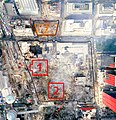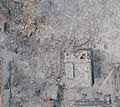4 World Trade Center (1975–2001)
| 4 World Trade Center | |
|---|---|
 The southwest corner of the Original 4 World Trade Center, as seen from Liberty Street on August 21, 2001. | |
 | |
| Alternative names |
|
| General information | |
| Status | Demolished |
| Type | Office |
| Architectural style | Modern |
| Location | Lower Manhattan |
| Town or city | New York City |
| Country | United States |
| Coordinates | 40°42′38″N 74°0′45″W / 40.71056°N 74.01250°W |
| Current tenants | List |
| Construction started | c. 1972 |
| Completed | 1975 |
| Opened | January 1977 |
| Demolished | After September 2001 (heavily damaged on September 11, 2001) |
| Owner | Port Authority of New York and New Jersey |
| Technical details | |
| Floor count | 9 |
| Design and construction | |
| Architect(s) | |
The original 4 World Trade Center (4 WTC), also known as the Southeast Plaza Building, was a nine-story, 118 ft (36 m)-tall building at the southeast corner of the World Trade Center complex in Lower Manhattan, New York City. Completed in 1975, the building was designed by Minoru Yamasaki and Emery Roth & Sons. On September 11, 2001, the building was heavily damaged as a result of attacks carried out by the Islamic terrorist group al-Qaeda, and was later demolished. Its site is now the location of 3 World Trade Center and the new 4 World Trade Center.
History
4 World Trade Center was built on the site of the Hudson Terminal complex. Construction began in late 1972 after Hudson Terminal was demolished. The building and its portion of The Mall At The World Trade Center was completed in 1975. The first tenants, the Commodities Exchange Center, started to move into the building in January 1977.[1] On July 1, 1977, the Mercantile Traders finalized the move.[2] The building's major tenants were Deutsche Bank (Floor 4, 5, and 6) and the New York Board of Trade (Floors 7, 8, and 9).[3] The building's side facing Liberty Street housed the street-level entrance to The Mall at the World Trade Center on the basement concourse level of the WTC.[4]
4 World Trade Center was home to commodities exchanges on what was at the time one of the world's largest trading floors (featured in the Eddie Murphy movie Trading Places). These commodities exchanges collectively had 12 trading pits.[5][6]
Destruction
The Twin Towers of the World Trade Center were destroyed during the September 11 attacks, creating debris that destroyed or severely damaged nearby buildings, such as the original 4 World Trade Center.[7] Much of the southern two-thirds of the building was destroyed, and the remaining north portion virtually destroyed, as a result of the collapse of the South Tower. The structure was subsequently demolished to make way for reconstruction.
At the time of the September 11 attacks, the building's commodities exchanges had 30.2 million ounces (860,000,000 g) of silver coins and 379,036 ounces (10,745,500 g) of gold coins in the basement.[8] The coins in the basement were worth an estimated $200 million.[9] Much of the coins had been removed by November 2001;[9] trucks transported the coins out of the basement through an intact but abandoned section of the Downtown Hudson Tubes.[10] Many coins belonging to the Bank of Nova Scotia were purchased in 2002, repackaged by the Professional Coin Grading Service, and resold to collectors.[11]
Tenants
The following tenants had space at 4 World Trade Center at the time of the attacks:[3]
| Tenant | Square Feet Leased | Floors Occupied | Industry | Notes |
|---|---|---|---|---|
| Deutsche Bank | 273,991 | 4–6 | Financial Institutions | |
| New York Board of Trade | 125,000 | 7–9 | Government | |
| Overseas-Chinese Banking Corp.[12] | 6,516 | 7 | Financial Institutions | |
| Green Coffee Association | 7,500 | 5 | Personal Services | |
| Gelderman, Inc. | 4,000 | 7 | Personal Services | |
| Tony May's Gemelli Restaurant & Bar | 10,000 | 0 | Retailers/Wholesalers |
Gallery
- Former site plan, with original 4 World Trade Center at the southeast corner.
- WTC complex and neighboring buildings, on September 23, 2001. Remaining portion of 4 WTC visible at southeast corner. Footprints of the Twin Towers and 7 WTC highlighted.
- Site of 4 WTC in NOAA aerial image, oriented with south at left of image (September 23, 2001). Much of 4 WTC is destroyed (entire left of image), with only the damaged northern portion identifiable (at right).
- A bird's-eye view of the World Trade Center complex, September 17, 2001, with the original locations of the buildings.
References
- ^ "History of the Twin Towers". PANYNJ.gov. 2013. Archived from the original on December 28, 2013. Retrieved September 11, 2015.
- ^ "Mercantile Traders Move to Trade Center and a New Place to Shout About". The New York Times. New York City. July 2, 1977. p. 32. Archived from the original on February 19, 2022. Retrieved February 19, 2022.
- ^ a b "4 World Trade Center – Commodities Exchange Center". www.cnn.com. Retrieved April 16, 2024.
- ^ https://upload.wikimedia.org/wikipedia/commons/1/12/Pre-9-11_WTC_4_in_NYC_%282001-08-21%29.jpg
- ^ Kershaw, Sarah (October 9, 2001). "Glad to Be in the Pits, Wherever They Are; Commodity Traders Had Backup Plan". The New York Times. ISSN 0362-4331. Archived from the original on September 10, 2022. Retrieved September 10, 2022.
- ^ Colkin, Eileen (September 9, 2002). "One year later: Forward strides". InformationWeek. No. 905. pp. 32–34. ProQuest 229130559.
- ^ Glanz, James; Lipton, Eric (February 12, 2002). "Rescuing the Buildings Beyond Ground Zero". The New York Times. ISSN 0362-4331. Archived from the original on April 1, 2019. Retrieved September 10, 2022.
- ^ Fuerbringer, Jonathan (September 15, 2001). "After the Attacks: The Commodities; Hoard of Metals Sits Under Ruins Of Trade Center". The New York Times. ISSN 0362-4331. Archived from the original on September 20, 2022. Retrieved September 10, 2022.
- ^ a b "Millions in Gold, Silver Recovered From Rubble". Los Angeles Times. November 1, 2001. Archived from the original on September 10, 2022. Retrieved September 10, 2022.
- ^ Dunlap, David W. (July 25, 2005). "Below Ground Zero, Stirrings of Past and Future". The New York Times. ISSN 0362-4331. Archived from the original on January 25, 2021. Retrieved September 18, 2022.
- ^ Martinez, Alejandro J. (August 6, 2003). "'Sept. 11' Coins Carry Hefty Markups, Baggage". Wall Street Journal. ISSN 0099-9660. Archived from the original on March 8, 2021. Retrieved September 10, 2022.
- ^ "Ministry of Foreign Affairs Press Statement on Terrorist Attack in New York and Washington (12 Sep@1445 hrs)". Ministry of Foreign Affairs (Singapore). September 12, 2001.




